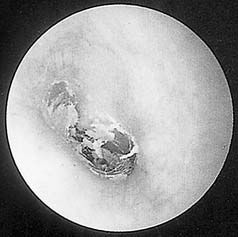CHAPTER 137 Infections of the External Ear
Otitis Externa
Definition
Otitis externa is an inflammatory (typically infectious) disorder of the external ear canal.
Incidence and Epidemiology
Acute otitis externa affects approximately 4 of every 1000 children and adults per year.1 Approximately 80% of cases occur in the summer, particularly in warm, humid environments.2 Other predisposing factors include anatomic obstructions of the ear canal (e.g., stenosis, exostoses, impacted cerumen), hearing aid or ear plug use, self-induced trauma (e.g., by cotton swabs), and swimming.
Pathogenesis
Bacterial
The initiating event is believed to be an abrogation of the hydrophobic ceruminous coating of the external canal.3 This event exposes the underlying epithelium to water and other contaminants, leading to edema and excoriation of the epithelial layer. These violations of the epithelium allow for bacterial infection. The resulting infection and inflammatory response lead to progressive erythema and edema of the epithelial and subcutaneous layers. These pathologic changes are associated with the symptoms of itching, pain, and otorrhea.
Fungal
Fungal infections of the external canal are generally considered to be opportunistic, occurring after treatment of bacterial infection. Superficial infection of the ear canal by yeast (Candida sp) can be seen in patients who use hearing aids. Aspergillus sp may induce a more aggressive infection, involving the epithelial and subcutaneous tissues (Fig. 137-1).
Chronic
Chronic otitis externa represents different disease states with distinct etiologies, as follows:
Microbiology
Roland and Stroman2 evaluated the microbiology of otitis externa. The results of their study are summarized in Table 137-1. Pseudomonas aeruginosa was the most common bacteria responsible for infections. Staphylococcus sp were the next most common pathogens. Fungi were responsible for only 2% of cases, but may be more prominent in cases of persistent or chronic infection.
Table 137-1 Microbiology of Otitis Externa
| Organism | % |
|---|---|
| Pseudomonas aeruginosa | 40 |
| Staphylococcus epidermidis | 9 |
| Staphylococcus aureus | 8 |
| Other Staphylococcus sp | 8 |
| Coryneform (diphtheroids) | 9 |
| Other gram-negative rods | 9 |
| Streptococcus, Enterococcus | 4 |
| Aspergillus, Candida | 2 |
From Roland PS, Stroman DW. Microbiology of acute otitis externa. Laryngoscope. 2002;112:1166-1177.
Clinical Manifestations
Examination of the canal may reveal the following findings:
Investigations
Investigations are rarely required for cases of otitis externa. Cultures for bacteria and fungus are indicated in cases of persistent or refractory infection, particularly to identify fungal infection. Special reference must be made to the value of sensitivities of the infectious organism to various antibiotics provided by laboratory culture tests. These sensitivities are based on expected tissue levels of systemically administered antibiotics. Sampling of otorrhea after administration of topical preparations has shown a concentration of antibiotic several orders of magnitude greater than can be obtained by systemic administration, however, even 8 hours after dosing.4 Organisms listed as “resistant” to a particular antibiotic are likely to be susceptible to the antibiotic when it is given topically. This is true for so-called resistant cases of Pseudomonas sp or methicillin-resistant Staphylococcus aureus. As long as the topical drop can reach the infected site, systemic antibiotics are unnecessary even in cases of infection by “resistant” bacteria.
Treatment
Careful débridement of the ear canal in any case of otitis externa is crucial to facilitate clearance of the infectious organism and to allow topical medications to reach the target tissue. If the ear canal is so edematous that topical medication would not reach its medial extent, an ear wick may be inserted. Classically, the physician made these from strands of cotton. Currently available Merocel wicks (Medtronic, Inc., Jacksonville, FL) offer better absorption of the drug, however, and expand when wet to decrease canal edema substantially. Although unpopular in North America, good results can also be obtained by packing the ear canal with antibiotic-impregnated ribbon gauze.5
Quinolone antibiotics are available in otic and ophthalmic solutions. They offer single-agent coverage for pathogenic bacteria, with virtually no risk of contact dermatitis or ototoxicity. Ofloxacin (Floxin) is available for treatment of external and middle ear disease and is equal to PNH in efficacy.6,7 Its main disadvantages are a neutral pH (6.2 to 6.8), the absence of a steroid, and expense. Ciprofloxacin is available as an otic preparation combined with hydrocortisone and as a newer formulation combined with the more potent dexamethasone (Cipro HC and Ciprodex). These solutions are acidic and contain a steroid. The hydrocortisone in Cipro HC may leave a precipitate in the canal, and both solutions are expensive.
When choosing a topical treatment of otitis externa, there is currently minimal clinical evidence to support the use of one solution over another. Existing literature is difficult to interpret because studies differ in their outcome measures and in the degree of aural toilet used. A systematic review of topical treatments by Rosenfeld and colleagues8 reached the following conclusions: (1) topical antimicrobial and topical antiseptic drops were superior to placebo; (2) a topical antiseptic (with a steroid in most cases) was as effective as a topical antibiotic; (3) topical quinolone and nonquinolone antibiotics were equally effective except in achieving a bacteriologic cure, where the quinolones were more effective; and (4) a topical antibiotic is as effective as a topical antibiotic and steroid preparation. Chapter 138 contains further information on costs and emerging resistance with quinolone ototopicals.
Fungal otitis externa can be treated with meticulous débridement and acidification of the ear. As with bacterial infection, topical treatment cures most cases, although recurrence rates are high. Clotrimazole 1% solution (Lotrimin) is available over the counter and provides broad-spectrum antifungal activity. Cresylate otic and ketoconazole ointment are effective as well.9 An alternative popular treatment is painting the canal and tympanic membrane with dyes that possess antifungal properties (e.g., gentian violet). Tolnaftate (Tinactin) solution can be used safely in the presence of a tympanic membrane perforation.10,11 Finally, persistent Aspergillus
Stay updated, free articles. Join our Telegram channel

Full access? Get Clinical Tree



